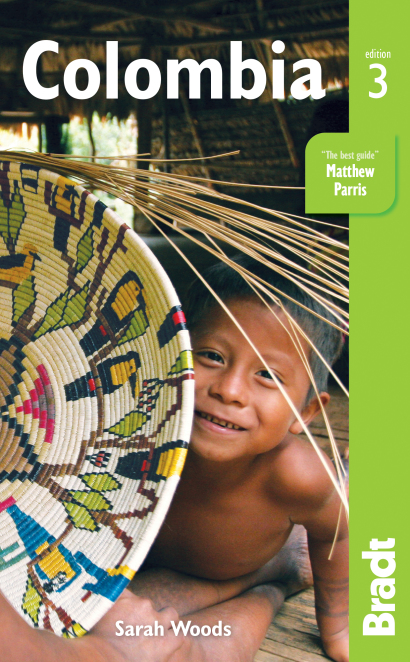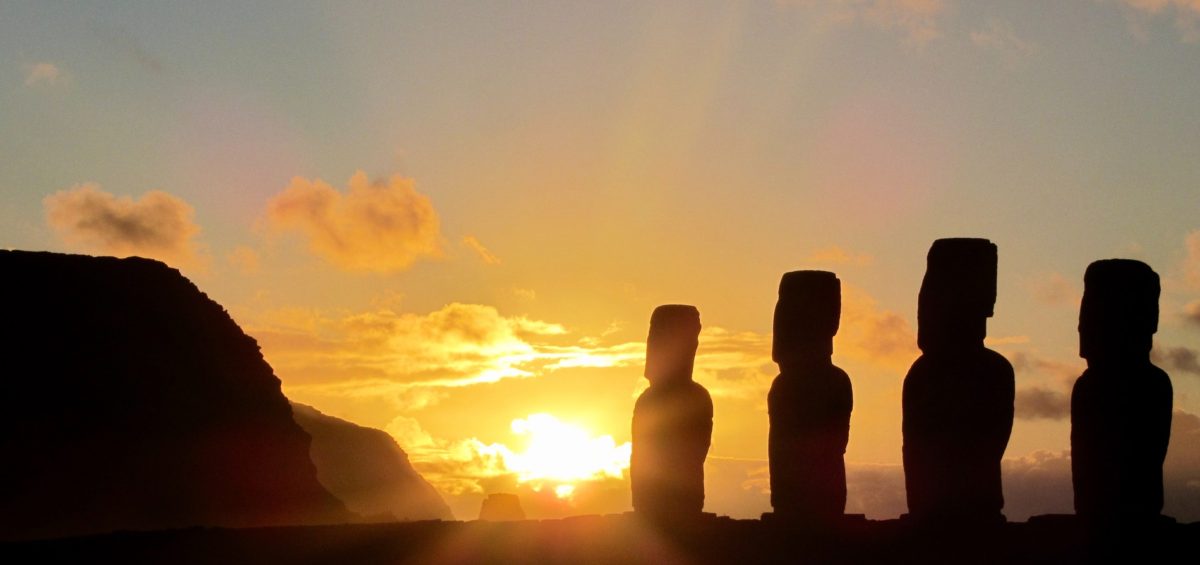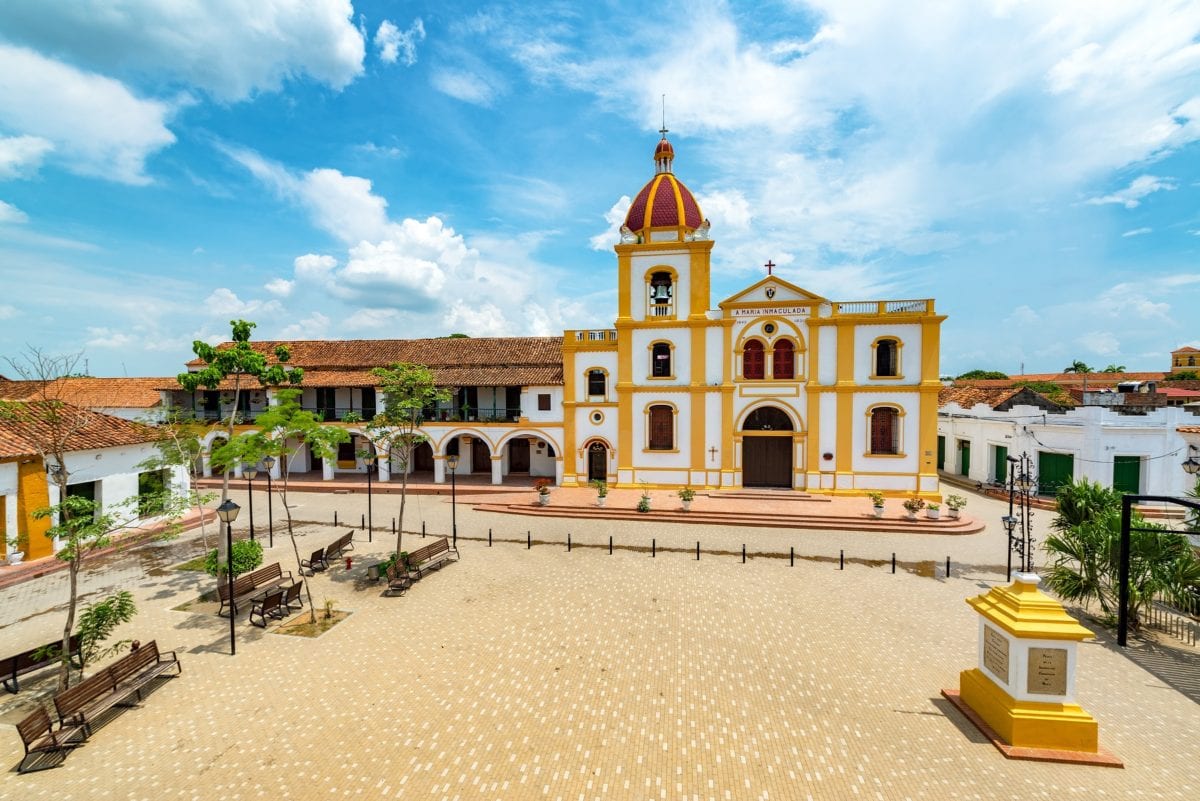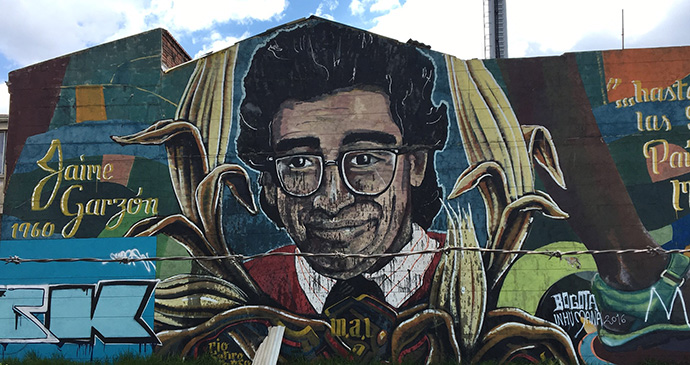Colombia’s two coastlines have very distinct characteristics: from the boggy horseshoe bays, inlets and jutting marshland peninsulas that epitomise the Pacific shoreline to the Caribbean’s sandy beaches, palm-fringed islands and saline pools.
Sarah Woods author of Colombia: The Bradt Guide
As the only South American nation with coastlines on both the Atlantic and Pacific oceans, Colombia offers amazing diving on coral reefs, outlying islands and beaches in a variety of amber, silver, white and salt-and-pepper sands.
Colombia’s two coastlines have very distinct characteristics: from the boggy horseshoe bays, inlets and jutting marshland peninsulas that epitomise the Pacific shoreline to the Caribbean’s sandy beaches, palm-fringed islands and saline pools.
Huge rolling rivers, gushing streams and flamingo-topped lagoons dot a dramatically contrasting terrain that sees curvaceous grasslands run to reed-trimmed wetlands and snow-capped mountain peaks; lunar-like craterous deserts; lush, vine-tangled rainforests; flower-filled meadows and tufted fields of coffee.
Shaped like an oversized fraying bedsheet, Colombia is South America’s fourth-largest country (after Brazil, Argentina and Peru) at 1,141,748km2 and is characterised by a location near the Equator that creates an extraordinary diversity of climates, vegetation, soils and crops. In the countryside that edges the foothills of the Andes, pretty red-and-white fincas nestle in green forests.
On the country’s northernmost tip, simple thatched-topped huts line many of palm-scattered idyllic white-sand beaches. Along the Caribbean coast, fine colonial settlements painted in bright bubblegum hues line charming paved courtyards and cobblestone streets. While in the Amazon basin, dozen of indigenous cultures speak more than 60 languages in a region that is home to the greatest number of bird species on earth.
Journey along the inky-green might of the Amazon River amongst 1,500 butterfly species, 1,800 bird species, 800 insect species, 2,000 species of reptile and amphibian, 3,200 species of fish, 51,220 plant species – in a region that is home to a staggering 10% of all species found on the planet.
On the jungle-thick Pacific Coast, turquoise waters are rich in marine life; resplendent swathes of dense palms and ferns teem with insects, birds and colourful blooms. In the interior region, vast canyons, magnificent waterfalls and bubbling thermal springs stud rugged terrains that contain creeper-clad ruins from ancient civilisations in a land where the pre-Colombian gold and sacred sites that spawned the myth of El Dorado remain to this day.
The isolated, mystical mountains of Santa Marta boast the highest point in the country along its fault-bounded granite massif at 5,775m atop the twin peaks of Cristóbal Colón and Simón Bolívar. Hikers and wildlife watchers can delve into forests that are home to armadillo, jaguar, tapir, ocelot, monkey and puma.
A mix of ethnicities and dialects reflect Colombia’s many border influences from Panama, Venezuela, Ecuador and Brazil and Peru. Colombia is also the setting of Colombian writer Gabriel García Márquez’s massively popular novel One Hundred Years of Solitude – a story as entrancing as the country itself.
For more information, check out our guide to Colombia:
Food and drink in Colombia
In the last decade Colombia has experienced a gastronomic explosion, attracting world-class chefs to its thousands of restaurants to create a culinary scene that is one of Latin America’s best-kept secrets. Much of this modern gastronomic ID is found in Bogotá’s über-cosmopolitan restaurant districts, where Colombian Creole classics and champagne and oyster bars rub shoulders with pan-Asian fusion diners and stylish French brasseries. Yet Colombia’s sophisticated international culinary triumphs aren’t just confined to the swish bistros of the capital city. Mini-gastronomic circles are springing up in cities such as Cali and Medellín and the resort areas in Cartagena, creating an exciting alternative to Colombia’s traditional culinary staples. Yet, fear not – typical Colombian fare (comida criolla) remains very much in evidence on every street corner, from the sidewalk vendors selling paper-wrapped tamales to the hearty plates of chicken, rice, fried plantains and red beans served as comida corriente (set meal) in cantinas nationwide. Expect to find plenty of variations on comida criolla during a journey across Colombia, each with its own distinct twist. On the Caribbean coastline the focus is seafood, especially lobster, while in the Andes a guinea pig dish is a regional delicacy. In Bogotá, ajiaco (a stew of chicken and potatoes) promises to keep citydwellers warm during seasonal frosts, while generous helpings of sancocho soup are served using at least a hundred different recipes in every town from Leticia to El Cabo.
Vegetarian food
Colombia has a growing number of good vegetarian restaurants, although these are confined to the larger cities. Most are in Bogotá, Cali and Medellín, but there are a few surprises in Buenaventura, Meta and Barranquilla to name just a few. Juice bars, organic food shops, health stores and delicatessens are also found throughout the capital. Some of Colombia’s vegetarian diners feature on the international listing www.happycow.net. Entries also state if the menu is vegan, lacto, organic, eat-in or take-away.
Health and safety in Colombia
Health
Healthcare in Colombia is reasonably good, especially in cities where getting modern medical treatment fairly fast poses little problem. In rural areas, however, don’t rely on finding any medical care. Arrive prepared with any medicines that might be needed and a first-aid kit, and plan for unforeseen emergencies. Health centres in most towns should be able to treat minor ailments and costs are usually very low. However, treatment is paid for at the time it is administered so it is important to have access to cash. Ask for a receipt if you intend to claim on your health insurance and be prepared to pay upfront if an ambulance is required. Medical staff in towns or rural areas may not speak English, so it may pay to look up some useful Spanish phrases beforehand, such as the names of allergies to medicines or words about pregnancy, etc. Take out health insurance before your visit to Colombia, and if you intend to trek or hike – a policy should cover every eventuality, including being evacuated for more advanced hospital care.
Safety
Although conflicting stories abound about safety in Colombia, the issue of travelling without incident here remains an important consideration. Those planning to criss-cross the country should do plenty of thorough research – whilst remaining mindful that Colombia thrives on urban myth and is prone to circulating safety information that is out of date. This country remains a place where there is danger, although the present security situation is much improved. Today, it offers the safest travel conditions for many decades and visitors who apply common sense should expect an incident-free stay. Take safety warnings extremely seriously and stay away from regions that are totally out of bounds. Red Zones under the control of warring factions are found in the south of the country, while some city slum areas are highly dangerous no-go areas where violence is rife.
Female travellers
Colombian women are highly politically active and appear extremely confident in social situations. However, machismo still plays a large role in Colombia and female travellers may feel less vulnerable in a group. Those travelling alone should be prepared for the occasional come-on, flirty comment and wolf-whistle from Colombian men – it is part of the culture and something that is best accepted with good grace. Expect it to happen wherever you are, be it a city or rural village – react without hostility but firmly ignore the attention. Avoid acting coy, shy or giggly as this may be misinterpreted as interest. Dressing in short skirts or revealing tops will only exacerbate the situation so stick to conservative clothing – even if the local girls are flaunting their bodies. Some travellers resort to wearing a wedding ring in order to put off male advances – it may work but will rarely stop a persistent suitor. Women who plan to party or drink in bars should remember that dancing with men or accepting drinks may also be construed as interest. Avoid drinking to excess as this will make you vulnerable and when leaving a bar or party make sure you are in a group. Never accept a lift, or walk home, with someone you don’t know, or have just met. Attacks on female tourists are rare with robbery a more common motivation than sex crimes. However, if anyone you don’t know approaches you on the street or on the beach, offering tours (or anything else) don’t wait to hear his patter – walk away.
Travellers with a disability
Colombia isn’t the easiest place for travellers with a disability, especially those keen to leave the major cities behind. Provincial roads tend to be unpaved, pot-holed and are often little more than dirt tracks. Although wheelchairs and mobility aids are available in large malls and shopping centres, they are rare in rural areas. Adaptations and amenities also vary from place to place. This inconsistency makes planning ahead difficult. However, Colombia’s National Institute for the Blind (Instituto Nacional para Ciegos, INCI) has made considerable inroads in campaigning for public information to be available in Braille. There are just over two million deaf people in Colombia, according to Federación Nacional de Sordos de Colombia, an organisation established to promote sign language (known as LSC) in 1984. Two constitutional laws for deaf people passed in 1996 recognise Colombian sign language and requires captioning or sign language on television.
Wheelchair ramps are also mandatory in new public buildings, although compliance is poor in this respect outside of urban centres. The Murillo Toro post office building in Bogotá has an entrance ramp, as does the Ministry of Education, but older buildings are rarely modified for disabled access and usually contain steep flights of steps. Much of Colombia’s public transportation system is also inaccessible, impairing the free movement of people with disabilities countrywide. The exception to this is the TransMilenio in Bogotá and Medellín’s Metro system, both of which have special facilities for disabled passengers and wheelchair users.
LGBTQ+ travellers
Colombia has a relatively small gay scene confined to its major cities but has witnessed significant improvements in gay and lesbian rights in recent years. However, discrimination remains rife, despite Colombia’s increasingly liberal social attitudes. Today, it may be easier to be openly homosexual in major cities but in rural areas the attitude towards gays and lesbians shows little sign of softening. Dozens of groups in Colombia have conducted anti-gay campaigns under such names as ‘Death to Homosexuals’. Even a human rights ombudsman once described homosexuals in a television interview as ‘abnormal faggots’ that should be subject to ‘social control’.
However, Colombia does have openly gay politicians, an active gay and lesbian information network and an active gay rights group – Bogotá-based Colombia Diversa, founded in 2004. Consensual homosexual activity was decriminalised in 1980 with amendments to the Criminal Code so there is a single age of consent of 14. In 2003, following strong opposition from the Catholic Church, an extremely progressive bill to give legal recognition to lesbian and gay partnerships was shelved. However, in February 2007 the Colombian Constitutional Court ruled that same-sex couples are entitled to the same inheritance rights as heterosexuals in common-law marriages. Even Colombia’s powerful Catholic hierarchy backed the bill on the basis that it didn’t include same-sex marriage or adoption. According to Colombia Diversa at least 100,000 couples will benefit from the new legislation, which is one of the most progressive gay rights reforms in Latin America. In 2010, gay rights advocates gathered in protest in Bogotá after Colombia’s Constitutional Court voted five to four to dismiss a lawsuit arguing for a change in the country’s civil code that would allow same-sex marriage.
Travel and visas in Colombia
Visas
Citizens from most western European countries (including the UK), Australia, New Zealand, the USA and Canada only need a valid passport to enter Colombia. A 30-, 60- or 90-day tourist visa will be issued on entry without the need to apply for any other visa in advance. Those planning to stay for up to 90 days should notify immigration officials as they tend to issue 30 or 60 days as standard.
Once in the country, extended stays of over 90 days should be arranged by visiting the Office of Immigration Affairs in Bogotá to submit an application. Those planning to work or study in Colombia will need to apply for the relevant visa from the Colombian consulate in their home country before they leave.
Citizens from restricted countries need to apply for a tourist visa in the Colombian consulate in their country of origin.
Whether arriving by plane or land, visitors must hold a return or onward ticket to prove an intention to leave the country. Furthermore, the ticket out of the country should be dated within 90 days to avoid difficulties at immigration. It is also entirely possible that proof may be required to show sufficient funds exist to cover your stay. Passport and visa requirements can change without much notice, so check with the Colombian embassy in advance of your trip.
Don’t forget to allow for the airport tax on departure, which is currently 71,000COP for a 90-day stay but less for a 60-day stay. Make sure your passport is stamped on both arrival and exit, whether you enter by air, land or sea, or you may be liable for a fine. Individuals entering or leaving Colombia are only entitled to carry up to US$10,000 in cash.
Anything in excess of this may be confiscated. Recently, a British national carrying US$14,000 had US$4,000 confiscated by the authorities at the airport, despite his argument that the money belonged to both him and his wife, who was travelling with him.
Those entering by sea must report to the port’s local immigration office for a passport entry stamp within one day of arrival.
Getting there and away
By air
Colombia’s major international airports are El Dorado (www.Bogota-dc.com/trans/aviones.htm) in Bogotá (BOG), Alfonso Bonilla Aragón, Cali (CLO), José María Codova, Medellín (MDE), and Rafael Nuñez, Cartagena (CTG). Other popular international airports include Barranquilla (BAQ) and Bucaramanga (BGA). National airline Avianca (www.avianca.com) serves all international airports from most Latin American destinations as well as some cities in North America and Spain. The Avianca VIP lounge at El Dorado International Airport won the ‘Priority Pass Airport Lounge of the Year’ award in 2006.
Air France (www.airfrance.co.uk) operates from most western European destinations with stopovers on some routes. Iberia flies from Madrid to all the above airports, via Bogotá. American Airlines (www.aa.com), Northwest (www.nwa.com), Continental (www.continentalairlines.com) and Delta (www.delta.com) are the major airlines between the US and most of Colombia’s international airports. Copa (www.copaair.com) also provides services to New York, Miami and Orlando from Barranquilla, Bogotá and Cali.
From Bogotá, LAN Airlines (www.lan.com) connects to Miami, Quito, Ecuador and other South American destinations via stopovers. LACSA and TACA (www.taca.com) both connect between Bogotá and Latin American and some US destinations. Flying time is around 10½ hours from Madrid, 12 from Paris and 13 from London (exc stopover). Flying from New York takes 4½ hours and from Los Angeles 8 hours.
By sea
Most tourists entering by sea do so on cruise lines, where all necessary entrance formalities are taken care of by cruise staff. Several shipping companies dock on the Caribbean coast and it is possible to take a boat tour from both Colón and Kuna Yala (San Blas) in Panama to Colombia’s Cartagena. Those that do arrive in Cartagena by boat must visit the immigration office on the day of arrival for a Colombian entry stamp in their passport – fail to do so and you will be illegal in the country after 24 hours.
Getting around
By air
Flying is by far the safest, easiest and most convenient way of getting around the country, with around 984 airports (although only around 100 have paved runways). Most domestic flights take less than 60 minutes’ flying time. Some offer business class and economy tickets and serve a snack and a drink. Avianca, Latin America’s first airline, Aires, AeroRepublica and Satena are some of the large domestic carriers, although there are others.
By boat
There are an estimated 18,000km of waterways in the country. Both the Río Magdalena (Magdalena River) that intersects the country to the north of Bogotá and the Río Cauca (Cauca River) are navigable in parts (some 1,500km). However, you should thoroughly research any such project first. Wide rivers and jungle canals sound intriguing, but they can lead you to some extremely remote destinations, which could be dangerous in the light of the current guerrilla and paramilitary situation. Jungle canals around Leticia provide a safer option, and tour operators can supply advice.
When to visit Colombia
Climate
Colombia lies almost entirely in the so-called Torrid Zone: a part of the earth’s surface between the tropics of Cancer and Capricorn characterised by hot weather. However, Colombia’s climate varies as a result of the differences in altitude with seasons defined by periods of lesser or greater rainfall, with little or no temperature change. Weatherwise, the country can be divided vertically into four regions with the hot country (tierra caliente) stretching from sea level to roughly 1,100m. In the temperate zone (tierra templada) elevations reach 3,000m while the remaining land is dubbed ‘the cold country’ (tierra fría) as it exceeds 3,000m. The cold zone’s upper area marks the treeline and roughly denotes the limit of human habitation. Adjacent to the tierra fría are Colombia’s treeless regions. These can reach 4,500m and are bleak areas referred to as the páramos, usually with permanent snow (nevado). Expect an average of 24–27°C in the hot low-lying regions along the Caribbean coastline and outlying islands, but don’t be surprised if they rarely exceed 22°C in lofty Bogotá. Medellín is known as ‘La Ciudad de la Eterna Primavera’ (or ‘City of the Eternal Spring’) throughout Colombia for its pleasant year-round climate with minimal temperature variations.
When to visit
Like many countries, Colombia is experiencing a blurring of the seasons and unpredictable and atypical weather patterns have flummoxed meteorologists in recent years. However, generally speaking, Colombia’s verano (summer) is from December to March. These months and those from mid-June to mid-August tend to be the best times to visit, with the exception of the northern plains where the wet season continues. Some 90% of Colombia’s territory is below 915m, tropical and warm with temperatures averaging around 25°C. The Caribbean coast and the Amazon are extremely humid and rain is sporadic and unpredictable even in the dry season. As you ascend Colombia’s Andes the temperature will drop around 6% per 1,000m. And, at an altitude of 1,980m, you’ll find yourself amongst glaciers, where temperatures can be as low as –17°C.
This range of climate and scenery is one of Colombia’s best assets and the country offers visitors the full spectrum of travel opportunities. Adventurous travellers can hop between the snow-capped peaks of the Colombian Andes and the Caribbean’s tropical turquoise waters and golden sands. Those looking for a more relaxed break can simply pick their preferred holiday – mountain hike, Caribbean beach, city jaunt or jungle trek are just some of the many, many choices available. High season in Colombia can be busy with hordes of domestic vacationers. Visit during the celebratory months of Carnaval (in Barranquilla, Feb/Mar), Semana Santa (Holy Week, Mar/Apr) or Navidad (Christmas) and plans should be made well in advance with hotels and transport booked. In addition, check for regional celebrations, when towns, villages and even roads close entirely to enable locals to enjoy the fiesta. Unless you dislike big or lively crowds, these regional and national festivals are a great way to become immersed in Colombia’s different cultures. Witness colourful rituals, dancing and the relaxed side of local life, as businesses close for the holiday and people revel in a party atmosphere that can last several days – at least.
What to see and do in Colombia
Amazonia
Exhilarating, humbling and awe-inspiring, the Amazon River is roughly the size of Germany, spanning 643,000km2 and covering some 40% of South America as the largest lowland in Latin America. The river starts as a tiny trickle atop the snow-capped Andes Mountains and flows across the South American continent until it enters the Atlantic Ocean at Belém, Brazil. Reaching 40km in width at the height of the rainy season the mighty River Sea (as it is often referred to) can flood up to 350,000km2 of land. Stretches of the River Amazon are deep enough to accommodate ocean liners. Sections are fast-flowing and debrisscattered fed by over 1,100 tributaries, 17 of which are more than 1,000 miles long.
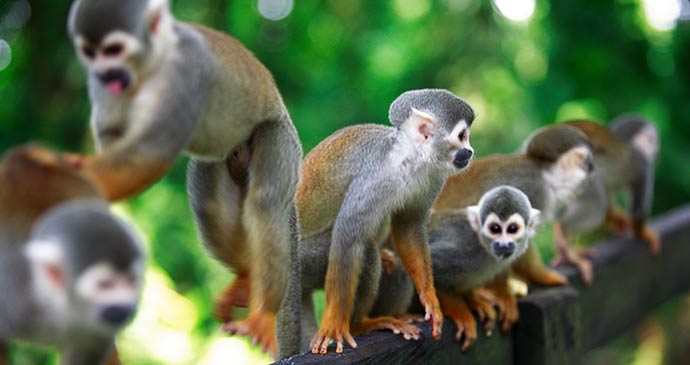
This mammoth watershed contains over two-thirds of the earth’s fresh water in its rivers, streams and tributaries. From the headwaters of Peru’s Ucayali-Apurímac river system the river flows for 6,400km to Brazil via Colombia, a distance slightly shorter than the Nile River but roughly the equivalent of a journey from New York City to Rome. Tiny wood-and-thatch Indian villages hug emerald vine-tangled riverbanks to the cacophony of squawking crimson parrots, chattering monkeys and whining insects in the treetops overhead. Piranha, crocodiles and dugout canoes navigate the waters of the mighty Amazon River and its many tributaries. Indian tribes hostile to strangers hide themselves away in the rainforest, living much as they did before the arrival of the Europeans, hunting, fishing and eating a diet of berries, plants and fruit. Giant blue butterflies and water lilies the size of serving trays are just a couple of the highlights in this magical, surreal land. Hot, sticky conditions complete with vast swarms of hungry mosquitoes and reddish glue-like mud prevail along this brooding river stretch of inky green.
As a region, the Amazon is home to at least 7,500 species of butterfly, 1,800 birds, 800 insect species and almost 2,000 species of reptile and amphibian. It contains 3,200 species of fish and is home to a staggering 10% of all species found on the planet. Botanists have recorded 51,220 species of plant, but doubt they will ever be able to catalogue everything in the lifetime of the world. In a single acre of forest, as many as 100 arboreal species have been counted. Up to 121 million litres of water per second are generated by the River Amazon with an average of three million tonnes of sediment deposited each day near its mouth. The annual outflow from the river accounts for 20% of all the fresh water draining into the entire world’s oceans.
Bogotá
Once a byword for danger, the city of Bogotá has undergone a significant clean-up act in recent years, following a passionate campaign aimed at nurturing societal change. Visionary leaderships have ignited fresh fire into the belly of Bogotá’s eight million inhabitants via a host of pioneering strategies that have helped change the mindset and behaviours of a once unruly urban sprawl. Today, Bogotá is a cosmopolitan city on the up, a metropolis that bears the signs of modern self-improvement.
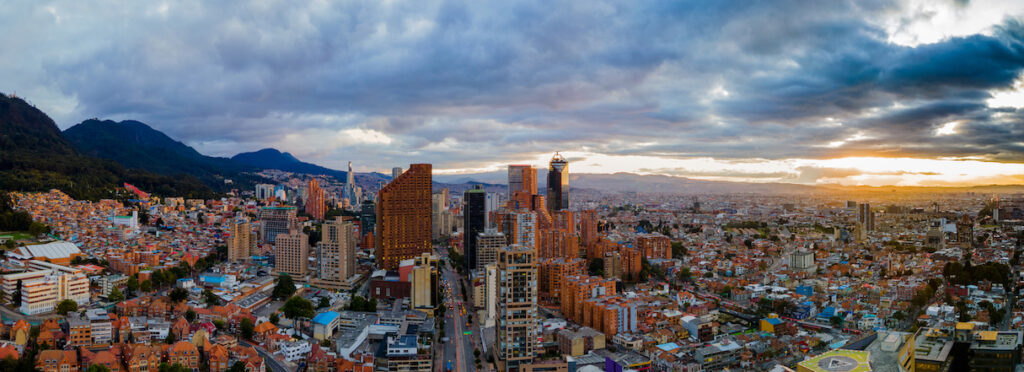
Sleek skyscrapers and a futuristic transit system are symbols of an (almost) transformed city that boasts 4,594 public parks. Thousands of cyclists of all ages criss-cross Bogotá’s wide, green expanses on Latin America’s largest bikepath network. Car use is restricted to lessen congestion. Vehicles no longer park on sidewalks and basic traffic laws such as stopping at a red light, giving priority to pedestrians, and buses stopping only at bus stops are largely obeyed (except perhaps by busetas). Citizenship is no longer a laughable concept in the city and today the mood is one of highly charged optimism. Designer stores, swanky cafés, lounge bars and fine restaurants are testament to Bogotá’s ambition to become one of the most desirable cities on the radar. Sunday in the city is a family day when the streets take on a party atmosphere of clowns, music and picnics in the parks. Food vendors, churchgoers and mothers with pushchairs converge on the plazas and compete for space with armies of pigeons. Jugglers take centre stage on empty roundabouts while old women on flower stalls sit amongst a fragrant kaleidoscope of varicoloured blooms. Paths are freshly swept and roads free of rubbish in a place where choking smog once dominated the cityscape. Today the people of Bogotá love and respect their city – it is now oh-so chévere (cool) to be Bogotano, a far cry from the sentiment of a decade ago when it was a place that was truly loathed.
Yet modern-day Bogotá still has its many problems, some of which are born out of a rapidly expanding refugee population displaced from Colombia’s rural provinces. Constant streams of migrants arrive in the capital full of high hopes, only to find the city’s streets aren’t paved with gold. Most of these poor peasants end up in the makeshift shanty towns that sprawl along Bogotá’s fast-decaying southern nub. Conditions are nothing short of horrendous with sanitation and fresh water scarce. Piles of rotting rubbish are scavenged for a glimmer of hope in sewageswamped streets that are as lawless as they are vile. Pickpockets plague the shopping malls and all sorts of evils roam the streets after dark yet, despite this, Colombia’s ‘first city’ refuses to be in the doldrums. Bogotanos are largely a morally responsive, socially conscious and fashionably introspective bunch – so the mood within vast swathes of the city is upbeat. Big hotels are also expressing confidence in Bogotá’s promising future – that Hilton returned to open a swanky US$27 million hotel in 2009 and Hyatt pledged US$100 million in 2010 is a clear show of faith. However, the vast disparities that exist between the affluent north and poverty-stricken south are nothing short of shocking – two very different faces of Bogotá, wrapped around the bubblegum-coloured colonial core of the old quarter of the city.
Cali
Caleños consider their passion for music and their beautiful women a source of great pride. Cali appears to be permeated by an irrepressible rhythmic pulse as Colombia’s undisputed ‘salsa city’. Every arterial in this modern urban sprawl seems to throb with a percussive Latin beat as Cali’s party people come out to play. Having imported salsa and other Latin American musical genres from Cuba and Puerto Rico, Caleños are rapturous about staccato merengue rhythms, samba and rumba classics and syncopated ta-tum-ta-tum bossa nova beats. Even on a weekday, hip-swaying salseros can be found sashaying and snaking through downtown arepa stalls bound for downtown salsotecas (salsa bars).
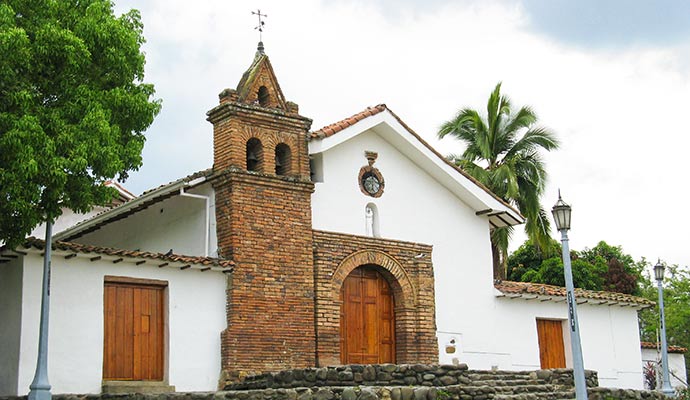
High-heeled women in skin-tight garb click their heels to the sound of drumming timbales and claves while car stereos emit the powerful boom of tumbao, cuica and cavaquinho. A row of neon-lit basement dancehalls emit a cocktail of pan-Latino melodies so sweet it can almost be imbibed. More than 130 salsa orchestras, 5,000 salsa students, dozens of music stores and instrument makers, over a hundred salsotecas and numerous conga, bongo and maracas players give Cali its character – along with an energetic nightlife that requires plenty of stamina. Cali is also home to a week-long salsa festival – the largest on the planet – that celebrated its 50th anniversary in 2007. This kaleidoscope of music and dance is not for the faint-hearted. Indeed, it’s as hot, claim the Caleños, as the women of the city and its year-round sultry heat.
Los Llanos
Los Llanos – ‘the flat plains’ – is a vast grassland savanna that sprawls to the east of the Andes in northwest Colombia and Venezuela. These cattle-clad seasonally flooded lowlands cover over 50% of the country’s total landmass, comprising rolling grassy knolls, scrubby pasture and prairies dotted with ranches. The region’s main river is the Orinoco with gentle slopes that lead away from higher elevations, which barely rise above 200m. Herdsmen in Los Llanos raise mammoth droves of cattle over many thousands of acres with stud farms, horses and cow fields the lifeblood of Colombia’s ‘cowboy country’. Corralling, roping, ranging and lassoing are all-important skills in this rural hinterland where the nasal dialect of the Llaneros (plainspeople) remains peppered with phrases unchanged from the idioms of the first Spaniard settlers.
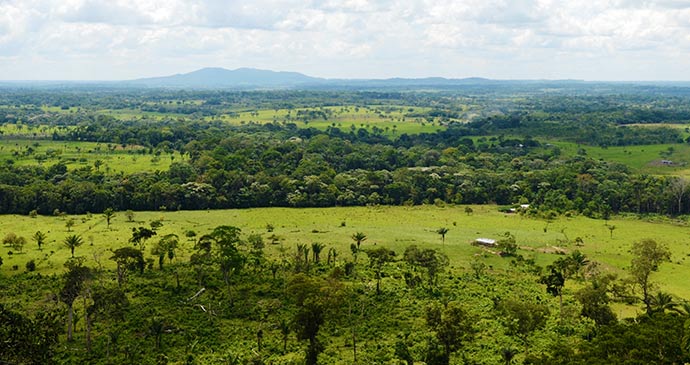
The Llaneros are proud of their hard lives and are dedicated cowboys from cradle to grave, spending long days enduring extreme heat and high winds in the saddle. Having learned how to ‘break’ horses while young, these gaucho-like ranchers enjoy a provincial culture rich in folklore, legends and stories. It is hard to image a Colombian song more poignant than those of Los Llanos’ heartfelt lilting lyrics to the melodic strum of the cuatro guitar or harp. A true Llanero is a legendary figure on the ranches of Colombia and these accomplished horsemen often wear the distinctive traditional working clothes of a poncho, straw hat and cotizas (rope-soled sandals).
Los Nevados National Park
Travellers keen to hike through some of Colombia’s most striking terrain will find this 583km² patch of the Andes fits the bill. Not only does this snow-caked range of volcanic peaks – topped by the 5,325m-tall Nevado del Ruiz – offer truly incredible views from trails that climb through cloudforest but it is also relatively easy to access and, most importantly, safe. However, it is very cold and the altitude can pose problems health-wise. On this basis, anyone not feeling 100% fit should give Los Nevados a miss.
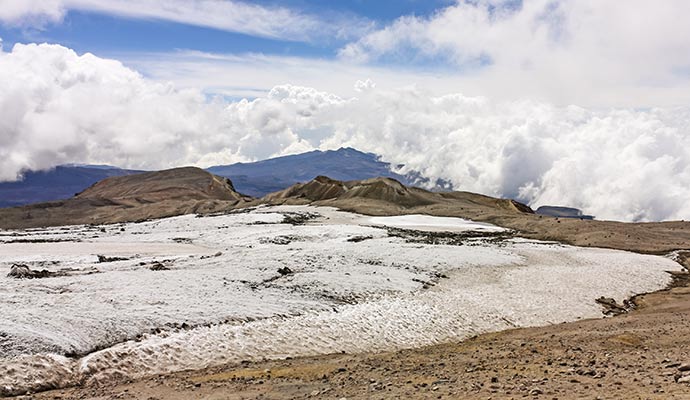
A hike to the summit of the still-active Nevado del Ruiz takes about three hours. Varying altitudes ensure a collection of well-maintained paths wind through considerable diverse terrains, from humid thickets and cool highland scrubland to crisp, white snow and ice. Popular with skiers and budding volcanologists, the range comprises El Tolima (5,215m) at the southern end followed by El Quindío (4,750m), Santa Isabel (4,950m), El Cisne (4,750m) and then El Ruiz in the north. The park attracts mountaineers from all over the world, many of whom traverse all four peaks. This takes about seven days to complete and is a highly popular challenge.
But it is not just the climbing that has made these mountains famous. On 13 November 1985 at precisely 21.08 Nevado del Ruiz erupted – with catastrophic results. Within four hours vast lava flows had travelled over 100km, leaving total devastation in their wake. More than 23,000 people were killed and more than 5,000 injured. The town of Armero (population 27,500) at the mouth of the Río Lagunillas canyon was hardest hit, disappearing entirely under the mud. Thousands of villagers along the Chinchiná, Gualí and Lagunillas rivers fled in fear as their homes surrendered to the lahars.
San Andrés Archipelago
Colombia’s only oceanic department – the West Indies department – is one of the most isolated island regions in the Americas, located 800km northeast of the Colombian mainland, just 150km from the Nicaraguan coast. Laid-back locals pride themselves on being barefoot champions of leisure in a calypso culture that is a world away from fast-paced Bogotá. Warm Caribbean waters are home to a cluster of palm-scattered atolls, islets and cays in an archipelago where 300,000km2 forms the main constituent of a UNESCO Seaflower Biosphere Reserve (Reserva de la Biosfera Seaflower). Fertile waters, grass beds and mangrove-clad lagoons host a magnificent array of bird species with isolated soft-sand beaches and undisturbed coral reefs rich in underwater flora and fauna.
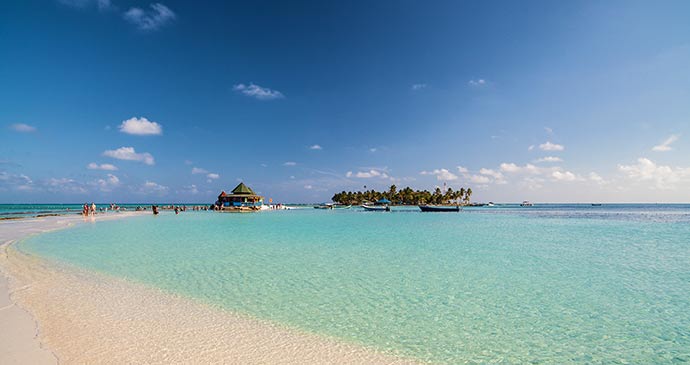
Three inhabited islands form the archipelago’s geographical and spiritual heart, as immortalised in the lyrics of Colombian musician Francisco Zumaque’s catchy chart-topper ‘San Andrés’. Around them lie five uninhabited atolls to the north and two to the south with a liberal scattering of sandbanks and cays in between, including the submerged islet of Alicia Shoal.
Related books
For more information, see our guide to Colombia:
Related articles
From crumbling Persian empires to colossal Roman cities, here are some of our favourite ruined civilisations from around the world.
Sit back and enjoy this kaleidoscope of colours.
Ben Box travels around Colombia to explore the impact of the landscape on García Márquez’s works and relationships
Winner of Bradt’s New Travel Writer of the Year competition 2016, tells the story of his first trip away from his daughter.
